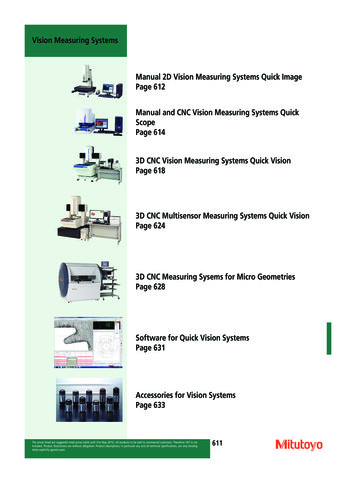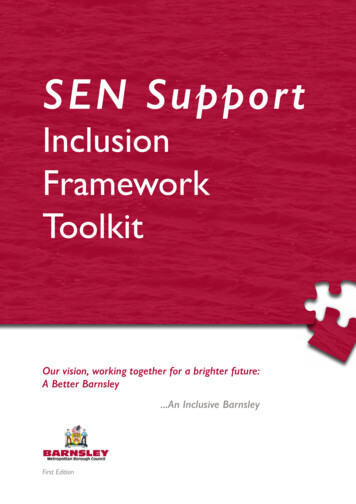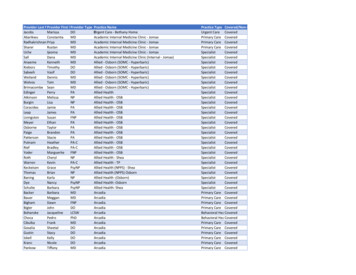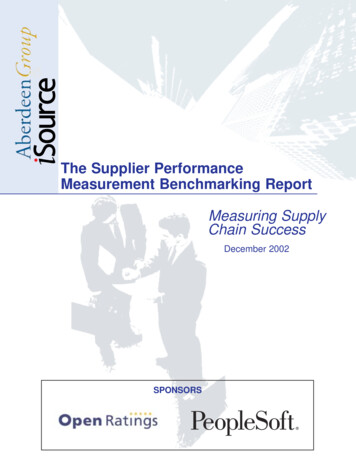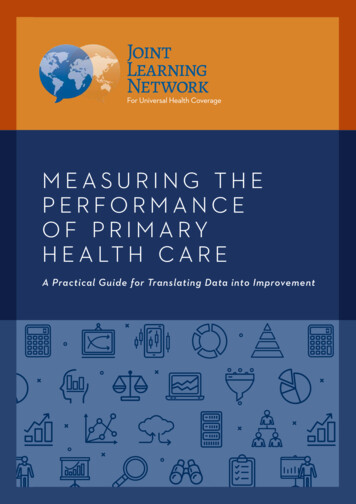
Transcription
ME AS URIN G T HEP ERFO RM AN CEO F PRIMARYH E ALTH CAR EA Practical Guide for Translating Data into Improvement
ME AS URIN G T HEP ERFO RM AN CEO F PRIMARYH E ALTH CAR EA Practical Guide for Translating Data into Improvement
This toolkit was produced by the Joint Learning Network for Universal Health Coverage (JLN).The JLN is an innovative community of practitioners and policymakers from around the world who are actively engaged inexchanging knowledge about the challenges they face and co-developing practical solutions for implementing universal healthcoverage (UHC). The resulting tools, which harness the practitioners’ expertise and experiences, guide countries in designingand implementing efficient, equitable, and sustainable health care systems while contributing to global knowledge on achievingUHC. This toolkit was created in consultation with the Primary Health Care Performance Initiative (PHCPI), a partnershipthat brings together country policymakers, health system managers, practitioners, advocates, and other development partnersto promote improvements in primary health care (PHC) in low- and middle-income countries through better measurementand knowledge sharing.For questions or inquiries about this toolkit or other JLN activities, please contact the JLN at jln@r4d.org. 2018 by Results for Development (R4D). All rights reserved. The material in this document may be freely used foreducation or noncommercial purposes, provided that the material is accompanied by an acknowledgment. If translated or usedfor education purposes, please contact the JLN at jln@r4d.org so we may have a record of its use.This work was funded by generous support from the Bill & Melinda Gates Foundation. The views expressed herein are solelythose of the authors and do not necessarily reflect the views of the institutions with which they are affiliated.Recommended citation: Measuring the Performance of Primary Health Care: A Toolkit for Translating Data intoImprovement. Joint Learning Network for Universal Health Coverage, 2018.
Technical EditorsPia Fernandez-Davila, Ministry of Health, ChileChloe Lanzara, Results for Development, USANicolás Figueroa, Ministry of Health, ChileMeredith Kimball, Results for Development, USARafiqul Islam, Ministry of Health and Family Welfare, BangladeshAllyson English, Results for Development, USAErick Gaju, Ministry of Health, RwandaWesley Solomon, Results for Development, USANaniek Isnaeni, Tangerang District Health Office, IndonesiaAuthorsZalilah Abdullah, Ministry of Health, MalaysiaSamuel Nkeng Akwe, Ministry of Health, CameroonSamsiah Awang, Ministry of Health, MalaysiaKoku Awoonor-Williams, Ghana Health Service, GhanaSamuel Buabeng-Frimpong, Ghana Health Service, GhanaJean-Baptiste Byringo, Rwanda Biomedical Center, RwandaFaaikah Fauziah Ehsan bte. Zainal Ehsan, Ministry of Health,MalaysiaKhaleda Islam, Directorate General of Health, BangladeshRachel Koshy, Ministry of Health, MalaysiaRizki Mahardya, Center for Health Financing Policy andInsurance Management, IndonesiaSiti Haniza Mahmud, Ministry of Health, Malaysia (retired)Isabel Maina, Ministry of Health, KenyaJacqueline Matsezou, Ministry of Public Health, CameroonAbdullah Ngonyo, Ministry of Health, KenyaKamaliah Mohamad Noh, Cyberjaya University College ofMedical Sciences, MalaysiaSamuel Chukwuemeka Obasi, National Primary Health CareDevelopment Agency, NigeriaAnthony Ofosu, Ghana Health Service, GhanaAlexis Ahumada Salinas, Ministry of Health, ChileHumberto Silva, independent consultant to the Ministry of Health,ArgentinaHarikumar Sivanandan, National Health Mission, Kerala, IndiaT.S. Selvavinayagam, Government of Tamil Nadu, IndiaM. Senthilkumar, Government of Tamil Nadu, IndiaAlbert Tuyishime, Rwanda Biomedical Center, RwandaContributorsToye Femi Adedokun, Federal Ministry of Health, NigeriaAtikah Adyas, Ministry of Health, IndonesiaAdeyeye Arigbabuwo, Ibijola Group of Hospitals and AppleyardMedical Clinic, NigeriaRudy Kurniawan, Ministry of Health, IndonesiaRuth Laari, National Health Insurance Authority, GhanaPhuong Nguyen Khanh, Health Strategy and Policy Institute,VietnamVijayakumar Krishnapillai, Health Action by People, IndiaHabtamu Abelneh Liyew, Federal Ministry of Health, EthiopiaLuis Martínez Liévano, Federal Ministry of Health, MexicoAnalia Lopez, Ministry of Health, ArgentinaSudharshana Mahaletchumy, Ministry of Health, MalaysiaCharles Mamman, National Primary Health CareDevelopment Agency, NigeriaAngela Maske, Georgetown University, USAEngelbert Manga, Ministry of Public Health, CameroonIbelcar Molina, Secretariat of Health, MexicoAndrew Muhire, Ministry of Health, RwandaJulius Mutiso Mulonzi, Ministry of Health, KenyaMisari Ibiam Ndidi, National Health Insurance Scheme, NigeriaBelinda Nimako, Ghana Health Service, GhanaLauren Perry, Recon Strategy, USASugma Purbowo, Yarsi Medical School, IndonesiaMohammad Jahangir Alam Sarker, Ministry of Health andFamily Welfare, BangladeshKadkkal Swayamvaran Shinu, State Health Resource Center, IndiaLuciano Strucchi, Programa SUMAR, ArgentinaTran Thi, Health Strategy and Policy Institute, VietnamAsfaw Girma Tola, Federal Ministry of Health, EthiopiaAdolfo Martinez Valle, Performance Evaluation Ministryof Health, MexicoLetitia Wiafe, Ghana Health Service, GhanaReviewersCaren Althauser, PATH, USACheryl Cashin, Results for Development, USALaurel Hatt, Results for Development, USALisa Hirschhorn, Northwestern University, USADoni Arianto, Ministry of Health, IndonesiaGina Lagomarsino, Results for Development, USAKhuong Anh Tuan, Health Strategy and Policy Institute, VietnamMuchiri Nyaggah, Local Development Research Institute, KenyaJamal Uddin Chowdhurry, Bangladesh Medical Association,BangladeshFederica Secci, World Bank Group, USAPolycarpe Efouba Awono, Ministry of Public Health, CameroonMarty Makinen, Results for Development, USAXimena Barros, Ministry of Health, ChileHannah Ratcliffe, Ariadne Labs, USAEndang Diarty, Social Security Organizing Agency, IndonesiaJean-Paul Dossou, Research Centre in Human Reproduction andDemography, BeninLydia Dsane-Selby, National Health Insurance Authority, GhanaElisabeth Koa Eloundou, Ministry of Public Health, CameroonNkiondalle Epote, National Health Management InformationSystem, CameroonKatie Stahley, Bill & Melinda Gates Foundation, USACicely Thomas, Results for Development, USACourtney Tolmie, Results for Development, USA
ContentsPreface . . . . . . . . . . . . . . . . . . . . . . . . . . . . . . . . . . . . . . . . . . . . . . . . . . . . viiiIntroduction . . . . . . . . . . . . . . . . . . . . . . . . . . . . . . . . . . . . . . . . . . . . . . . . . ixPa r t 1 :Assessing Existing Measurement Systemsa n d I d e n t i f y i n g G a p s . . . . . . . . . . . . . . . . . . . . . . . . . . . . . . 1Chapter 1: Identifying Measurement Priorities . . . . . . . . . . . . . . . . . . . . . . . . 3The PHC Conceptual Framework . . . . . . . . . . . . . . . . . . . . . . . . . . . .3Adapting the Framework . . . . . . . . . . . . . . . . . . . . . . . . . . . . . . . . 4Creative Solutions for Common Challenges . . . . . . . . . . . . . . . . . . . . . .7Chapter 2: Identifying Measurement Gaps and Selecting Indicators . . . . . . . . . . . 9Conducting a Gap Analysis . . . . . . . . . . . . . . . . . . . . . . . . . . . . . . 10Creative Solutions for Common Challenges . . . . . . . . . . . . . . . . . . . . . 15Pa r t 2 :A d d r e s s i n g M e a s u r e m e n t G a p s i n K e y A r e a s . . . . . . . . . . . . 1 9Chapter 3: Measuring Technical Quality . . . . . . . . . . . . . . . . . . . . . . . . . . . . 21Why Measure Technical Quality? . . . . . . . . . . . . . . . . . . . . . . . . . . . 22How to Measure Technical Quality . . . . . . . . . . . . . . . . . . . . . . . . . . 22Creative Solutions for Common Challenges . . . . . . . . . . . . . . . . . . . . . 27Chapter 4: Measuring Experiential Quality . . . . . . . . . . . . . . . . . . . . . . . . . . 35Why Measure Experiential Quality? . . . . . . . . . . . . . . . . . . . . . . . . . 36How to Measure Experiential Quality . . . . . . . . . . . . . . . . . . . . . . . . 36Creative Solutions for Common Challenges . . . . . . . . . . . . . . . . . . . . 44Chapter 5: Measuring Community Engagement . . . . . . . . . . . . . . . . . . . . . . . 49Why Measure Community Engagement? . . . . . . . . . . . . . . . . . . . . . . . 49How to Measure Community Engagement . . . . . . . . . . . . . . . . . . . . . . 50Creative Solutions for Common Challenges . . . . . . . . . . . . . . . . . . . . 55
Pa r t 3 :M a n a g i n g D ata a n d L i n k i n g D ata S o u r c e s . . . . . . . . . . . . . . 6 1Chapter 6: Improving Data Quality . . . . . . . . . . . . . . . . . . . . . . . . . . . . . . . 63The Data Production Lifecycle . . . . . . . . . . . . . . . . . . . . . . . . . . . . 63Reviewing Data Quality . . . . . . . . . . . . . . . . . . . . . . . . . . . . . . . . . 66Creative Solutions for Common Challenges . . . . . . . . . . . . . . . . . . . . . 68Chapter 7: Linking and Managing Disparate Data Systems . . . . . . . . . . . . . . . . . 69Setting Up a Data Warehouse . . . . . . . . . . . . . . . . . . . . . . . . . . . . . 69Creative Solutions for Common Challenges . . . . . . . . . . . . . . . . . . . . . 81Pa r t 4 :U s i n g D ata f o r D e c i s i o n - M a k i n g . . . . . . . . . . . . . . . . . . . . . 8 3Chapter 8: Communicating Data to Key Audiences . . . . . . . . . . . . . . . . . . . . . 85Creating a Data Communication Plan . . . . . . . . . . . . . . . . . . . . . . . . 85Visualizing Data . . . . . . . . . . . . . . . . . . . . . . . . . . . . . . . . . . . . . 92Using Data Visualization Software . . . . . . . . . . . . . . . . . . . . . . . . . . 93Creative Solutions for Common Challenges . . . . . . . . . . . . . . . . . . . . . 96Chapter 9: Using Data for Decision-Making . . . . . . . . . . . . . . . . . . . . . . . . . . 97The Data to Improvement Pathway . . . . . . . . . . . . . . . . . . . . . . . . . . 97Systems and Capacities to Support Data Use . . . . . . . . . . . . . . . . . . . . 98Engaging Decision-Makers . . . . . . . . . . . . . . . . . . . . . . . . . . . . . 100Engaging Stakeholders Through Routine Data Reviews . . . . . . . . . . . . . 102Building a Culture of Data Use . . . . . . . . . . . . . . . . . . . . . . . . . . . . 104Creative Solutions for Common Challenges . . . . . . . . . . . . . . . . . . . . 108Conclusion . . . . . . . . . . . . . . . . . . . . . . . . . . . . . . . . . . . . . . . . . . . . . . . . . . 110Appendix A: Defining Primary Health Care . . . . . . . . . . . . . . . . . . . . . . . . . . . 112Appendix B: Development of the PHC Conceptual Framework . . . . . . . . . . . . . . 113Appendix C: Templates . . . . . . . . . . . . . . . . . . . . . . . . . . . . . . . . . . . . . . . .115References . . . . . . . . . . . . . . . . . . . . . . . . . . . . . . . . . . . . . . . . . . . . . . . . . . 122
P r e fac eThis toolkit was developed by the Primary Health Care Measurement for Improvement (M4I)Collaborative, a network of delegates from 15 countries that are committed to improving their primaryhealth care (PHC) systems as a critical foundation for achieving universal health coverage (UHC) andrecognize the importance of using PHC performance data to do so.Supported by the Joint Learning Network for Universal Health Coverage ( JLN) in consultation with the Primary HealthCare Performance Initiative (PHCPI), the collaborative was launched in April 2016 with the goal of developing toolsand approaches to help policymakers, health system managers, and frontline providers use data more effectively for PHCimprovement. In support of this goal, M4I Collaborative members collectively produced this toolkit to guide practitionersthrough the process of measuring performance and using data for improvement, including in difficult-to-measure servicedelivery areas where little measurement guidance has previously existed.The toolkit was developed through a combination of in-person workshops and virtual engagement that drew on the practicalexperiences of M4I Collaborative member countries, including Argentina, Bangladesh, Benin, Cameroon, Chile, Ethiopia,Ghana, India, Indonesia, Kenya, Malaysia, Mexico, Nigeria, Rwanda, and Vietnam. In-person workshops hosted by Ghana,Malaysia, Rwanda, and Vietnam allowed participants to share their experiences with PHC service delivery and performancemeasurement, identify common measurement gaps and challenges, and explore strategies for improving PHC performancemeasurement. Country participants worked closely with JLN technical facilitators from Results for Development (R4D), withsupport from PHCPI partners from Ariadne Labs and the World Bank Group, to document these lessons and combine themwith global expertise in PHC measurement and data analytics to produce this toolkit.The authors gratefully acknowledge the Bill & Melinda Gates Foundation for its generous funding of the M4I Collaborativeand the JLN country representatives for their leadership and contributions.pa g e v i i i
IntroductionAchieving universal health coverage (UHC)—the delivery of high-quality essential health servicesthat are accessible to all without risk of financial hardship—is an important priority for many countriesand is included in the Sustainable Development Goals (SDGs) set forth by the United Nations. Globally,there is growing agreement that primary health care (PHC), with its ability to address up to 90% ofa population’s diverse health needs, is central to the achievement of UHC. Strong PHC is not simplythe provision of basic services, however. It is an integrated approach to care that addresses the healthneeds of the majority of the population—from curative care to prevention and health promotion—andforms the foundation of efficient, equitable, responsive, and resilient health systems.Despite the promise of PHC, the World Health Organization’s Tracking Universal Health Coverage: 2017 Global MonitoringReport reveals that at least half of the world’s population still lacks access to essential health services. Many countries aretaking concrete action toward strengthening their PHC systems and recognize that data on PHC performance are criticalto identifying areas for improvement, determining practical solutions, and monitoring progress. But challenges related to thecurrent state of health data systems often hinder improvement efforts. Many countries report that they are “drowning in data”while also struggling with measurement gaps, poor data quality, incomplete information, and fragmentation of data sources.A lack of routine feedback mechanisms often impedes efforts by system managers to take informed action at the community,facility, and national levels. Further, many countries lack the institutional structures and incentives that would enable effectiveuse of data for performance improvement.The Purpose of This ToolkitThis toolkit provides practical guidance, tools, and links to other resources to support countries in collecting better, moreuseful data on PHC system performance and using the data to improve performance. Depending on a country’s measurementcapacity and unique priorities, the toolkit can be used routinely or at strategic points to help with the following: Understanding PHC performance measurement across program areas and system functions Addressing measurement gaps in important service delivery areas, including technical quality, experiential quality, andcommunity engagement Ensuring data quality and linking fragmented data sources to improve the accessibility of PHC performance data Communicating data effectively to relevant stakeholders through targeted data analysis and visualization Identifying strategies for building the measurement systems, capacities, and organizational culture needed to effectively usedata for decision-makingMEASURING T HE PERFORMANCEOF PRIMARY HEALT H CAREpag e i x
How the Toolkit Is OrganizedThe toolkit is organized around the six-step Measurement for Improvement Cycle shown below—a framework originallydeveloped by the JLN Provider Payment Mechanisms and Information Technology Collaborative and adapted by the M4ICollaborative. The cycle consists of the necessary steps to identify measurement priorities, select appropriate indicators,collect the right data, improve data quality, analyze and communicate the resulting information, and use that knowledge tomake improvements.Measurement for Improvement CyclePart 4 offers guidance on translatingPart 1 explains how to assessdata into the information needed toexisting measurement systems andsupport decision-making and makeselect indicators as a foundationimprovements, with a focus onbuilding a culture of data use.for the rest of the toolkit.Use datafor decisionmakingIdentif ymeasurementprioritiesIdentif ymeasurementgaps and selectindicatorsAnalyze andcommunicatedataPart 3 explains how toManageandcentralizedataAddressmeasurementgaps in keyareasensure data quality and howto manage and link data sources.Part 2 covers how to addressmeasurement gaps in three keyareas: technical quality, experientialquality, and community engagement.Each chapter includes:Guidance derived from global expertise and country experienceOne or more tools developed or validated by country participantsA list of common challenges and creative solutions developed at the country or global levelTips and country examplesLinks to additional resourcespa g e x
Most of the tools are templates that countries can adapt to their own context in the process of building or implementing aPHC monitoring and evaluation (M&E) system. Blank versions of these templates are included in Appendix C . Some of thetools, including the PHC Indicator Inventory and its associated guidance, can be downloaded from the JLN website atwww.jointlearningnetwork.org.How to Use the ToolkitThe toolkit was developed by public-sector practitioners but is relevant to both the public and private health sectors. Somepractitioners may choose to implement the entire process laid out in the toolkit, while others may turn to specific chapters forguidance on particular issues. Examples of how policymakers and managers might use the toolkit include:Policymakers:refining an M&E system to ensuresufficient focus on PHCHealth information system manager:establishing a data warehouse andvisualization toolAs part of a mid-term review of the national M&Esystem, a country’s policymakers want to ensure thatthe system is collecting all the data needed to assessPHC system performance against priorities set out inthe national health strategic plan. Using the toolkit,the policymakers identify measurement domains thatalign with their goals and map existing indicatorsto those domains. They discover measurement gapsin several critical service delivery areas and use thetoolkit to devise strategies for new data collectionto fill them. The resulting revised national M&Eframework is more comprehensive and draws greaterattention to PHC priorities.Despite the collection of vast amounts of data, ahealth information system manager lacks a clearview across disease-specific programs and systemlevels, which limits her ability to comprehensivelyassess PHC performance. She uses the toolkit todevelop a plan for establishing a data warehouse thatintegrates fragmented data sources and enables thecreation of a routine management dashboard withdata visualizations. She then develops a proposal foradditional investment to create the data warehouse.District manager:creating a meaningfulcommunication planFacility manager:building a culture of data useA district-level manager knows that a lack ofcommunication between facilities and communitieshas resulted in low trust in the health system, but hedoesn’t have good data to show the impact on serviceutilization and health outcomes. With guidance fromthe toolkit, he implements a community engagementsurvey in a sample of communities in his district andinforms the regional directorate that facilities withcommunity engagement programs often have higherutilization rates and better outcomes. As a result,the manager receives funding to test the impact ofimproved community engagement programs acrossthe district.MEASURING T HE PERFORMANCEOF PRIMARY HEALT H CAREA facility manager recognizes that her facility’s stafflack the proper training and incentives to regularlyrecord patient-level data, resulting in incompletedata and poor data quality. She also realizes that eventhough the data are reported to the district level, theyare not regularly used within the facility to identifyareas for improvement. She uses the toolkit to identifystrategies to improve the culture of data use at herfacility, implements a training for clinical staff toimprove their administrative skills, and organizes amonthly staff meeting to review data and identifyimprovement strategies.pag e x i
pa g e x i i
1234part01Assessing ExistingMe asurement Systemsand Identifying Gapschapterchapter0102IdentifyingMeasurement PrioritiesIdentifyingMeasurement Gaps andS e l e c t i n g I n d i c at o r sEstablishing an effective measurement system starts with articulating clear measurement priorities:what questions are you trying to answer, and what do you need to measure? Part 1 addresses these initialsteps of the Measurement for Improvement Cycle as a foundation for the rest of the toolkit. Chapter 1lays out the critical determinants of PHC system performance and how to identify measurementpriorities. Chapter 2 explains how to determine whether existing measurement efforts are capturingPHC performance comprehensively by describing how to identify measurement gaps, select indicators,and determine what data should be collected.56789
tiveIdentifymeasurementprioritiesTo identify key measurement domainsand priorities for assessing theperformance of a PHC system567who isi n v o lv e d?toolPolicymakers, M&E officers,planning and implementation teams9»PHC Conceptual FrameworkThis chapter introduces the PHC Conceptual Framework , a tool developed by the Primary HealthCare Performance Initiative (PHCPI) to help identify key measurement domains and priorities forassessing the performance of a PHC system. It also offers guidance on adapting the framework to aspecific country context.The PHC Conceptual FrameworkThe PHC Conceptual Framework ( Figure 1 ) can help decision-makers identify their improvement priorities and determinewhat should be measured in order to support those priorities. The framework is not a replacement for existing measurementefforts; rather, it offers a way to better conceptualize performance by grouping indicators according to five interconnectedmeasurement domains: System components that affect PHC performance, from governance and policies to financing, surveillance, andpriority setting Inputs that are needed to deliver high-quality PHC services, from drugs and supplies to the health workforce Service delivery elements that influence the moment when care is delivered, such as community engagement, facilitymanagement, and provider competence Outputs in the form of effective coverage of high-quality preventive, promotive, and curative health services Outcomes that include improved health status as well as greater efficiency, equity, responsiveness, and healthsystem resilienceThe PHC Conceptual Framework can help practitioners organize existing indicators and identify gaps where new orbetter-quality data are needed (as described in Chapter 2 ). For more information about strong PHC performance and thedevelopment of the PHC Conceptual Framework , including the key performance questions that underlie each measurementdomain, see Appendix A .M E AS U RI N G THE P E RFO RM AN CEOF P RI M ARY HE ALTH CARE8pag e 3
figure 1.PHC Conceptual Framework1234A systemA1Governance &LeadershipA1.a PHC policies56QualityA1.b managementinfrastructureA1.c Socialaccountability7A2 Financing8A2.a Paymentsystems9HealthB inputsB1Drugs emsB4WorkforceB5FundsCservice deliveryPopulationFacilityC2 Organization &D1priorityC1.a LocalsettingTeam-basedC2.a careorganizationD1.a HealthpromotionManagementC1.b CommunityengagementC1.c EmpanelmentProactiveC1.d populationoutreachManagementFacilityC2.b managementcapability andleadershipC2.c InformationsystemsPerformanceC2.d measurementandmanagementFinancialA2.c coverageAdjustmentHealth NeedsA3.a SurveillanceA3.b Priority settingEffectiveServiceCoverageC1 HealthA2.b Spendingon PHCA3 to PopulationD outputsD1.b DiseasepreventionD1.c RMNCH*E outcomesE1Health StatusE2Responsivenessto PeopleE3EquityE4EfficiencyE5Resilience ofHealth SystemsChildhoodD1.d illnessD1.e InfectiousdiseaseNCDs andD1.f mental healthD1.g Palliative careC3 AccessC3.a FinancialC3.b GeographicC3.c TimelinessAvailability ofC4 Effective PHC* Reproductive,newborn, maternal,and child healthServicesC4.a ProvideravailabilityC4.b ProvidercompetenceInnovation andA3.c learningC4.c ProvidermotivationPatientC4.d providerrespect andtrustC4.e SafetyC5 High-Quality PHCC5.a First contact accessibilityC5.b ContinuityC5.c ComprehensivenessC5.d CoordinationC5.e People-centeredsocial determinants and context (political, social, demographic, socioeconomic)Source: Primary Health Care Performance InitiativeAdapting the FrameworkBefore using the framework to help identify measurement priorities, some countries may find it useful to adapt it to moreaccurately reflect their own context. This process involves engaging relevant stakeholders across the system to review theframework, adapt it, and validate the revised framework.1. Engage StakeholdersTo ensure that the adapted framework is comprehensive, reflects the priorities of key stakeholders, and will be used across thesystem, the adaptation process should be inclusive and based on consensus and compromise. Participants in the process willvary by country, but they may include policymakers, directors of PHC departments, M&E officers, planning teams, districtand facility managers, managers of vertical (disease-specific) programs, and frontline providers.pa g e 4
2. Review the FrameworkDiscussions about the framework should be based on a sharedunderstanding of terms and definitions and the aspects of performancethat each domain measures.In these discussions, views and priorities may differ, so it is important tobuild consensus around how to answer the key guiding question: Whatdo we need to measure to ensure that we are comprehensively assessingthe performance of our PHC system? (The Conceptual FrameworkMapping Guidance Tool introduced in Chapter 2 can help with thesediscussions.)Identify local populationhealth needs and healthsystem priorities early in theadaptation process to ensurethat PHC performance willbe appropriately evaluatedwithin the existing context.6The following questions may be helpful in the adaptation process. (Answering them may require document review orconsultations with relevant health system actors.) How is PHC defined in the local context, and what is its scope? Does the framework reflect health system priorities laid out in the national health-sector strategic plan? Does the framework take into account internal and external sources ofhealth care financing for PHC? Does the framework include the inputs required to deliver specific priorityhealth interventions? Does the framework reflect national health priorities and disease areasbased on the epidemiological profile of the country (particularly foroutputs and outcomes)?When adapting the framework,be sure to retain core componentsthat are critical to evaluating PHCperformance. Each of the fivesubdomains within the ServiceDelivery domain should be includedto comprehensively assess whetherservice delivery processes are leadingto high-quality, people-centeredPHC services.4. Validate the FrameworkOnce the PHC Conceptual Framework has been adapted, the final step is ensuring that it is approved by and disseminatedto key stakeholders who will be involved in its use. This can occur during review and adaptation discussions or as a separatevalidation exercise with a broader group. This approval is critical to getting buy-in from other key parties involved in PHCperformance measurement and improvement and to ensure alignment across measurement efforts.M E AS U RI N G THE P E RFO RM AN CEOF P RI M ARY HE ALTH CARE35Adaptations to the framework should be based on the national context. Examples of adaptations might include adding greaterspecificity to the Inputs domain, editing the Service Delivery domain to better align with local organization and manageme
useful data on PHC system performance and using the data to improve performance. Depending on a country's measurement capacity and unique priorities, the toolkit can be used routinely or at strategic points to help with the following: Understanding PHC performance measurement across program areas and system functions






